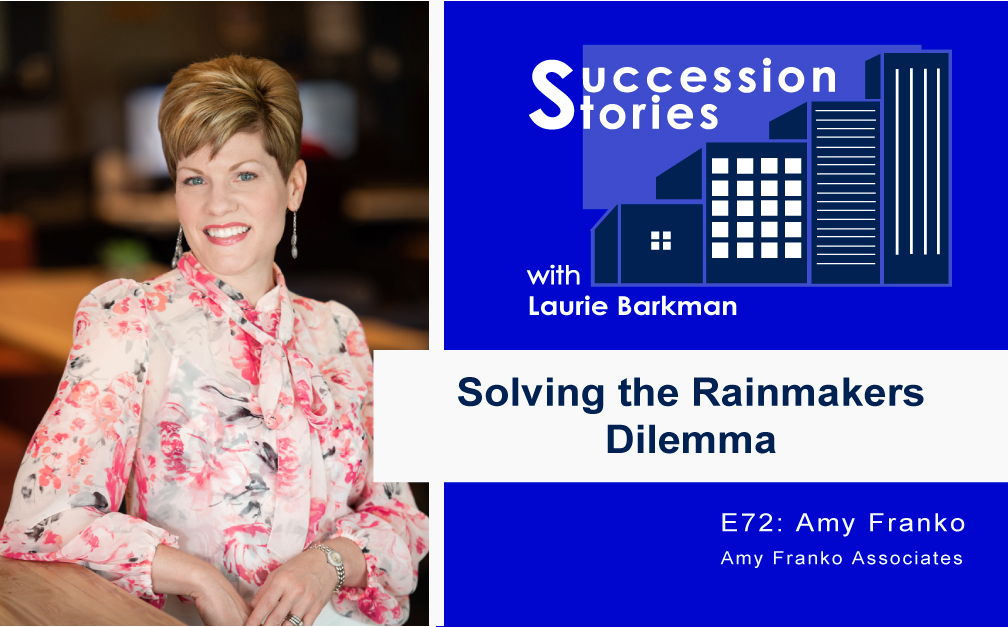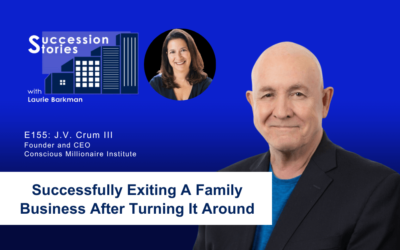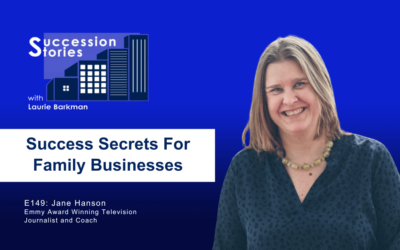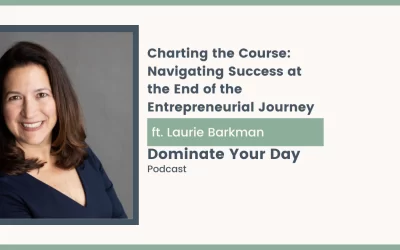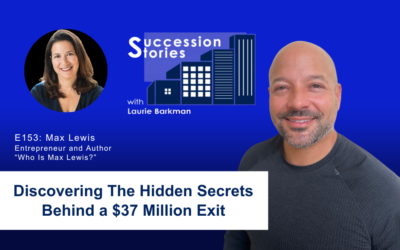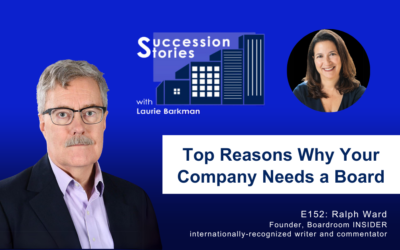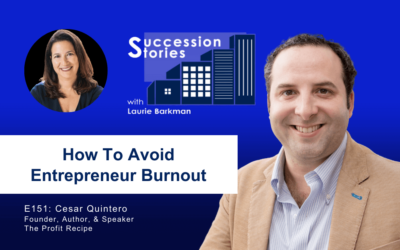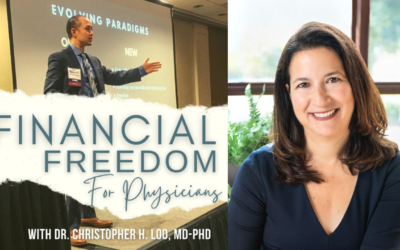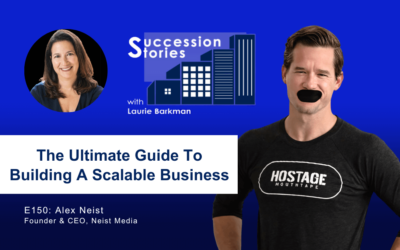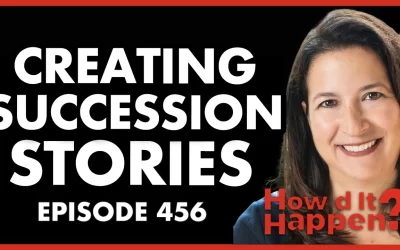If a high percentage of your company’s revenue is undertaken personally by you or your fellow equity holders, you’re a Rainmaker. You’ve got a strong ability to influence customers, but you may be lowering your company’s value. Amy Franko is a strategic sales expert and author of The Modern Seller. Listen in as Laurie Barkman and Amy talk about the challenge of The Rainmaker’s Dilemma, traps to avoid, and actions you can take to increase your company’s value.
Listen in to learn more about:
- Understanding The Rainmaker’s Dilemma and impact on business value
- Architecting a sales process
- Sales strategies to consider in a disruptive business environment
Connect with Amy Franko:
https://www.linkedin.com/in/amyfranko
Connect with Host, Laurie Barkman:
https://www.linkedin.com/in/lauriebarkman/
Transcript:
Laurie Barkman:
Amy Franko is a strategic sales expert and author of a book called The Modern Seller. We talked about the challenge entrepreneurs face as the primary economic engine in their business. It’s called the Rainmaker’s Dilemma. If a high percentage of your company’s revenue is undertaken personally by you or your fellow equity holders, you’re a Rainmaker. The good news is that you’ve got a strong ability to influence customers, but the bad news is that you may be lowering your company’s value. While there can be success, being the Rainmaker will eventually lead to a plateau in the value of your business. And businesses that can’t thrive without their owner have less chance of success in a sale. Listen in as Amy shares actionable steps to avoid the downhill trap of being the Rainmaker while helping you to increase your company’s value.
Laurie Barkman:
Amy, thank you so much for joining me on Succession Stories. You are the first person to come on the show that’s an expert in sales, and we’re going to have an awesome, focused conversation about sales. We talk about revenue on the show all the time. But the sales process and really thinking strategically about sales and connecting the sales process to enterprise value– we haven’t done before. So you’re the perfect person to have this conversation with. Welcome!
Amy Franko:
Thank you so much for having me. I’m really looking forward to our conversation today.
Laurie Barkman:
Why don’t we start with your journey. Tell me about your journey to become this sought after sales trainer and advisor.
Amy Franko:
Sure, So I got my start in technology. The first 10 years of my career I worked for IBM and I worked for Lenovo and I was, for most of that time, a quota carrying sales professional. I had some marketing roles and some project management roles to round out that experience, but I’ve always been really passionate about sales and business development and earning clients. It’s been, always, something that I’ve loved to do, and so I was fortunate enough to get my start in technology. Then after about 10 years I pivoted. Took a pivot into entrepreneurship. I always knew from an early age that I would either lead something or start something. With pivoting and entrepreneurship, I got the opportunity to do both, so for the past 15 years, I have been an entrepreneur, owning a professional services firm, essentially. That has evolved over the years and what it looks like today is, I work primarily with mid market sized organizations across a variety of different industries. I work with CEOs and I work with sales teams, sales leaders to help them accelerate growth through sales, because sales is the engine for revenue generation and ultimately profit generation and value in the business.
Laurie Barkman:
What I love about your story is your pivot; that you were in Big Co, can’t get much bigger than Big Blue, right? You pivoted into the entrepreneurial world, and you’re focusing a lot of your passion and skills into education. Really, at the end of the day, you’re teaching companies how to fish, you’re not doing sales for them right there. You’re teaching them how to have a sales process and to be better at enabling their team to be better. I bring that up in the sense that I think the show is an educational show. At the end of the day, it’s entertainment. But I want everybody who’s listening to the show to learn something. My joke is, “If you don’t learn something, I’ll give you the next one for free,” because as you know, there’s no fee to listen. But generally, everyone’s going to learn something.
Today, as we talk about this idea of educating business owners on this big question mark of sales and how can we be better, I also want to put it out there that if we can help educate them around business value, and this concept of what we call “The Rainmakers Dilemma.” It’s a quite a common problem actually, in founder-led organizations. Might be family-led, or just privately held companies that are smaller, and these business owners are focusing on their strengths, and maybe one of their strengths is their ability to influence customers so they’ve built this company around their ability to influence customers, and that has led to some really good things. It’s become the economic engine of the company. But the downside is that there’s probably not a whole team around them or if there is, they’re not percentage wise driving as much as the owner is and so we call that the Rainmaker’s Dilemma. Have you encountered companies in this circumstance?
Amy Franko:
Yes, absolutely. I encounter those types of companies pretty regularly and then the next iteration of that is an organization that has maybe a smaller sales team that they’re looking to grow in scale. This idea of the Rainmaker’s Dilemma, you had me thinking about some of the research that I did for my book, The Modern Seller, and a modern seller is entrepreneurial. So someone who starts an organization or maybe you are a second generation or third generation of a family-led business, someone started that business and had to be what’s called an entrepreneurial seller. There’s some research on this that comes out of the University of Chicago and their business school. The basic premise is, when an organization is started you have the CEO or the rainmaker as it is, who is primarily the face of the business, he or she is the person that’s out there, building client relationships, finding new business, they are that engine of revenue generation, if you will. Then there’s this shift that needs to happen if you’re going to grow the value of your organization, whether it’s to continue to pass it on to family generations, or perhaps you’re looking for an exit, at some point, the the value of your sales team, and the way in which you go about your strategy, your process, etc, becomes a really important piece of the value of your business, because you have to be able to show that you have the right processes and infrastructure in place to sustain and grow the business for the long term.
Laurie Barkman:
Absolutely. If you are not able to show a process, you’re not able to hand off a team that has success and proven success and bringing in new customers, then the owner is going to feel that trap and so the business can plateau, it can decline, and then of course, that’s going to hurt enterprise value over time. For a company that is looking to grow and to get out of this trap, what are some of the ways that the owner might make a transition to thinking about it differently? They have to build a sales and marketing engine, they have to become more of an architect, putting things in place. Let’s talk about that. Because as you said from your book, I think this will overlap with a lot of concepts that you’ve talked about in your book. What are some of those skill sets? What are some of those key things that we should be thinking about in our organizations and checking in on to see if we are in a rainmaker’s dilemma, and if we are, how do we get out of it?
Amy Franko:
Maybe I’ll start with that question first, so for anybody who is watching or listening to the show, you’re a CEO or maybe you’re part of the executive team. A couple of the ways that you know that you have a rainmaker’s dilemma is first and foremost, if the vast majority of the company’s sales are coming through one or maybe two people. So when that’s happening, and you have something that occurs in the organization, someone leaves or whatever that might be, maybe you lose a key client, it does happen, so you’re either dependent on one person, or one or two really key anchor clients, you know that you have the rainmaker’s dilemma, because ultimately, you’re in a vulnerable position that if someone leaves or a client leaves, that you could have some tough sledding ahead to be able to build that back up and get to where you need to be, so those are a couple of things to be watching for, and if you answered yes to either of those than you are a company that is in the rainmakers dilemma, and need to make that transition to the architect’s solution.
I would say first and foremost, it’s not an overnight transition. Laurie, I don’t know about you, but sometimes when I make a decision, and that Type A ambitious, driving personality that I am, it’s like, “Oh, I make this decision, and I want it to be tomorrow.” This takes some time, and there are a number of different levers that need to be pulled. I’m going to say something that maybe we’ll come back to a little bit later, but there’s an infrastructure piece also between sales and marketing. Marketing and sales are so integrated now that any CEO or leader of an organization cannot be thinking about sales or marketing without the other, so I want to make that point, and we can certainly come back to that. When I’m working with organizations on sales strategy, the infrastructure pieces of it, helping them to make that transition, there are essentially four pillars that I work with them on. I work with them on strategy, people, process and technology. Evaluating those pillars and making decisions about what goes into those pillars is going to ultimately help an organization make that transition from the rainmaker’s dilemma to the architect’s solution.
Laurie Barkman:
That makes a ton of sense. I mean, those are really, they’re not shocking to anyone as you lay them out, but when you lay them out that way, it makes so much sense and so for the organizations that haven’t yet done that, it might seem really daunting. Is this like a five year process, is this a two year? What can you do to get started? What is literally the first thing to do?
Amy Franko:
I would say, most organizations, if you have a five year strategy right now, that absolutely needs to be revisited, because there is so much disruption happening, a lot of my clients, and even some of my bigger clients are looking 12 to 18 months out in terms of their strategy. That’s one thing that I’ll mention, that if you’re looking at five years out, I challenge you to start looking at the next 12 to 18 months, so that you can start to wrap your mind around what you need to do next. In terms of where someone would start, I would recommend the strategy pillar, which probably makes a lot of common sense, because there are a lot of different pieces that can go into strategy, and people, process and technology ultimately filter into your strategy. When I’m working with clients, I will do some strategy work that helps them look at the next year to 18 months, and to start to put together the pieces whether it’s go-to-market strategy, it’s ideal client strategy, there’s a couple of different levers that you can pull in there as well. But that’s where I’m going to start.
Laurie Barkman:
Gotcha. Yeah, one of my clients is a smaller entity, they’re about five people and they were in the classic situation that the Rainmaker was the founder face of the company, his name is on the door, and they recognized that this was going to be a challenge and so they ended up, we ended up bringing in someone to help — in addition to myself — I work with them on the overall strategy, if you will, for the whole company in terms of where they want to go in transition planning and we identified this as a risk in the business and so I really like what you’re saying, because part of this, too, is that you can’t just jump into training, you have to figure out, what do you want to accomplish first, and designing and documenting this overall sales process.
Amy Franko:
Absolutely, and you can run some skill developments in parallel with strategy. Sometimes I will do that with clients where it makes sense, but having those foundational pieces in place. So for example, I might work with an organization on their product and services list, we might look at their current client list and take a look at the profitability, the revenue generation and the profitability of those clients. Do we need to be making some different decisions there? Those types of decisions then ultimately drive, who are who are the right people, and do we have them in the right roles? What roles do you need, and then what skills do they need in order to be successful? They’re all connected and each organization can be a little bit different in the order in which you go, but every organization ultimately needs all of them to be successful.
Laurie Barkman:
Absolutely. We talked about some of the measures, you just mentioned a couple of them so let’s talk about client lifetime value. What does that mean, and how do we measure that?
Amy Franko:
I personally see client lifetime value as a two way street. I was doing a program with a client of mine, and we did this exercise around client lifetime value. When I work with clients, and specifically on the skill development pieces, I will have them bring opportunities, prospective clients, current clients that maybe they’re looking to grow, so that they can use what they’re learning in these specific opportunities. So one of the exercises that we do is a client lifetime value exercise, and there are maybe eight or 10 different categories that that will score on and they range from the revenue and profit potential to ease of doing business to logo strength; if you are going to pursue landing a specific client, is there a reason why for branding or logo strength? So there’s a number of these different categories. But a little bit of a different take that I found to be successful is to look at it as a two way street. What value are we providing or could potentially provide to that client or prospective client? What value can they potentially provide back to us?
When I did this exercise with one of my clients, one of the folks in the program, she had said, “I brought this client to the program to work with and after doing this exercise, what I realized was, there was a lot more potential value in our relationship than I had previously assessed and that led me to put more resources into earning that client and it ultimately has turned into a multimillion dollar relationship.” Going through that type of exercise intentionally definitely has a lot of yields, because you can choose the clients that you want to work with that make the most sense for your business.
Laurie Barkman:
Absolutely. I like that. That’s a great way to look at it. The other thing I want to come back to, you mentioned the relationship between sales and marketing and I don’t work in marketing anymore the way I used to, but I’ll always be a marketer. [Laughs]
Amy Franko:
[Laughs]
Laurie Barkman:
The relationship between sales and marketing, I lived it for a long time, I totally understand, especially in this digital world, it’s so important to design your marketing and sales funnel so that it’s driving your marketing, qualified leads your sales qualified leads, what do those mean, there’s a lot of acronyms there, we call them the MQLs [Marketing Qualified Lead] and the SQL [Sales Qualified Lead], and sometimes there’s that rub of one side saying the other is not bringing in enough on the volume, or they’re not bringing the right quality mix. Let’s talk about that. Let’s talk about the marketing funnel, because if we can set that up it’s a really core piece of the puzzle.
Amy Franko:
Absolutely, and depending on where an organization is, and their journey, they may be at the beginning of a marketing journey as well. If they’re at the beginning of a sales journey, and building out a sales infrastructure, they are likely at the beginning of building out a marketing infrastructure too and then you have some decisions as a leader, “Where am I going to make my investments?” I personally believe in a balanced approach to those investments, you have to consider what goes into your marketing infrastructure, so the different technology pieces, the thought leadership that you’re putting out into into the marketplace, “How are we being viewed out in the marketplace, and are we building enough awareness and credibility for our organization and our brand, that it can actually drive people to our website?” It drives people to our other lead generation work. The marketing qualified leads and the sales qualified leads, my opinion on it is, you can bring a marketing qualified lead into an organization, which essentially means that someone has expressed an interest, they have expressed an interest in getting to know you and your organization better. But it doesn’t necessarily mean that there’s a specific opportunity for you to pursue. That’s where the sales team has to do the qualification work and the discovery work to understand whether or not there’s a good opportunity to pursue. They’re both important, but they do have different functions so any sales or any CEO leader has to be considering their marketing infrastructure, in addition to the pieces of their sales infrastructure.
Laurie Barkman:
Creating the brand, creating the infrastructure, creating the process, having the right people on the bus to do it. The other thing that I wanted to ask is about customization. If we’re selling widgets, and you can get a black one, a red one, whatever, but it’s a widget that’s not customized. This is the product, this is what we’re selling and it probably has an easier chance of scaling because you’re not customizing what you’re offering. The Rainmaker, in contrast, oftentimes gets to really know what the clients are looking for, what the customers are looking for, they want to make them happy. They want to satisfy those requirements and so they end up customizing more, and so it dilutes what we’re doing. That’s why I’m asking the question. Do you find that that’s part of the overall process? Looking at, “What are the products and services mix,” and, “Are we customizing too much?”
Amy Franko:
Yeah, so the short answer to that question is yes, that is part of looking at your product and services mix. It’s also looking at your opportunity cost. Customization is an opportunity cost, and no matter what it is that you’re selling, whether it’s a physical product, or a service of some kind, there is opportunity cost every time you put your hands on it to customize it and so thinking about part of that strategic thinking is if I’m going to pursue this opportunity cost, what is it? What is my bottom line for this client going to look like if I pursue that customization, and how could I potentially reuse that customization for other customers and clients into the future? Many times I find that customers get down a path of customization and they have somehow just found themselves there, “Oh, yes, we can absolutely do that,” and then a few steps down the road, you realize, “Well, we’re really in deep on this customization and it’s more work, it’s more cost, it’s more of an energy drain than what we were initially thinking that it would be.” That’s where, as the leader in the business, pulling the reins in on that, and being very intentional about the level of customization and specialization that you get into based on whatever it is that you’re selling.
Laurie Barkman:
Is it fair to say that someone who’s the owner of the business or the CEO should never go into a customer meeting alone?
Amy Franko:
Perhaps. I can relate, I am the person who says, “Yes, we can absolutely do that,” and then I have some folks on my team that say, “Why do we say that we could do that?” You might need someone to go with you, if you are someone who loves to say yes, to those types of requests.
Laurie Barkman:
There is that check and balance, but also probably the relationship building side, so that we’re expanding these relationships. I think for business owners, it just really feels like a positive thing. You know when your clients got married, you know the names of their kids, you know the names of their dog, you have this really tight relationship. But what happens when those handshake relationships end because of a death or retirement, I’ve seen it at large scale in large companies where there were two very large companies that had handshake deals, and very long standing, really nice relationship so this is multimillion dollar deals on a handshake, and there was a retirement, and so I know I’m talking about the small company, but I think this question, or this challenge could also come up in these larger companies, too.
Amy Franko:
Yes, absolutely, and you think about that example right there. Those types of multimillion dollar deals being done on a handshake, and then someone leaves the organization, that’s where you have a whole lot of disruption entering there. There’s this organizational design construct that’s called forming, storming, norming, performing and it applies to teams in the workplace. Essentially, you could take that same concept and apply it to the example that you just shared. When something, when that type of agreement or relationship gets disrupted, not only are you potentially losing that multimillion dollar contract, now you have this forming, storming, norming, performing that you’re starting all over again with the relationship building and your sales process.
Laurie Barkman:
Yeah, absolutely. One last sales question for you, and then I’m going to switch gears.
Amy Franko:
Yeah.
Laurie Barkman:
Some people talk about a sales culture, what does that mean to you?
Amy Franko:
I define sales culture as my four pillars; the strategy, people, process and technology that help an organization to intentionally and sustainably grow the business. You need all four of those pillars, and they all contribute to the sales culture of the organization. Do you have a healthy, productive, high performing sales culture? A lot of organizations love to say, “Yes, of course we do,” but when you actually look at that a little bit more deeply sometimes you have some areas where there might be some unintended consequences of product mixes and decisions and things that you do that can adversely impact your sales culture. It’s this totality of those four pillars together, and are you creating a healthy, productive, sustainable culture?
Laurie Barkman:
Does it come down to money? In my former organization, one of our leaders used to say that salespeople are coin operated.
Amy Franko:
My boss used to say that too.
Laurie Barkman:
Whenever I bring it up to people they’re like, “Oh, yeah, I get that. That makes sense,” How do you tie that together with sales culture? When I’ve heard the context of sales culture, it’s typically coming from salespeople, which to me, always translated to money. Like we need to have a sales culture, which ultimately was going to mean, of course, we want to be driving revenue in the business. But it was also perhaps, and it could have been just the culture of my organization, that it seems to be if we have a sales culture, that means it’s overriding other things and letting those other things go in the backseat and perhaps more of a prioritization not elitism on the team, but kind of like, “We are the priority therefore we should get over we want, we should be the most highly compensated…” you can see where I’m going here. To me in that context, the sales culture question always maybe had this undertone of, “We’re better than you.”
Amy Franko:
There can be. I think that there is definitely some danger in the ‘all salespeople are coin operated, we’re a coin operated culture’. There’s definitely danger in that this is where the CEO of the organization and a chief sales officer or VP of sales have a lot of potential influence over the culture that they’re building and I tend to see this more in large organizations where there’s a lot of different product and services mix. Let’s say for example, as a publicly traded organization, you have outside analysts that are providing pressure, and making public commentary on what your organization should be selling and those outside influences can impact the product services solutions mix that you then focus on, which then drives the behavior of the sales team, good or bad behaviors.
Now, many of our listeners likely are not running publicly traded organizations, but you could take the same concept and apply it to your organization, what pressures internal or external might be pressing down on you and your decision making over the types of clients that you pursue, the types of products and services, the level of customization that you pursue? Are you incenting sales teams in the right way? Are you building a culture where you’re avoiding some of that elitism, if you will, of a sales team? I think that shows up a lot in small organizations because you can’t hide so you see that quite a bit more in small organizations. But on the positive side, as a CEO or sales leader, you have greater influence over that because you’re running a smaller, more nimble organization.
Laurie Barkman:
For sure. Alright, so a couple quick hit questions for you. What is something about you that I would be surprised to learn?
Amy Franko:
I am the oldest of five, I have four younger sisters, and there is a 10-year age difference between me and my youngest sister. I am solidly a Gen Xer and she is solidly a Gen Y and so we all fall in between. That’s probably something that a lot of people don’t know about me.
Laurie Barkman:
You’re the leader of the band.
Amy Franko:
I am. Sometimes you might call it bossy, but I call it being a leader.
Laurie Barkman:
I love it. That’s where you got your skills from. I know you give back to your community, and I didn’t know if you would like to share one of the organizations that you’re involved with where you spend your time, talent, and treasure that you’d like to give them a quick plug.
Amy Franko:
Yes, absolutely. Thanks for asking. I am the Board Chair of the Girl Scouts of Ohio’s Heartland. We are one of 111 councils across the US and we serve almost 18,000 girl and adult members across 30 counties in central and southern Ohio. That is a cause that’s near and dear to my heart, and I’ve been the board chair. I’m in my third year as board chair of that organization.
Laurie Barkman:
We should mention you’re in Columbus, Ohio and so another organization that you and I, it’s how we met, was through Women for Economic and Leadership Development, and with that organization, you and I have both spent time on doing webinars and talking about board service. So that’s a great organization we’ll also share with with our audience. Last but not least is, do you have a favorite quote or anything to share about entrepreneurship?
Amy Franko:
One of the quotes that I’ve always kept top of mind and I’ve heard it many times over the years is, “In the mind of a beginner, all things are possible and in the mind of an expert, only a few.” What I love about that quote, and is especially for leaders, entrepreneurs; there’s this balance between owning your expertise and owning your space and being that credible expert to your clients and your prospective clients, and balancing that with really being curious and wanting to continue to learn and to challenge ourselves to not just do things the way that they’ve always been done, but to be willing to be uncomfortable and trying new ways of doing things so that we’re always growing and we don’t get stagnant.
Laurie Barkman:
That’s a great message and tie-in with everything we talked about today. I love that quote. That’s the first time anyone’s brought that up. If people want to connect with you, Amy, what’s a great way they can find you?
Amy Franko:
The best two ways to find me. First, on my website, amyfranko.com, and then secondly, on LinkedIn. If you are listening or watching today, I would love for you to connect with me on LinkedIn and let me know that you heard or saw me on the show.
Laurie Barkman:
Thank you so much for sharing your wisdom about sales and sales process. It’s given us a lot of ideas, actionable ideas about how we might get out of the Rainmaker’s Dilemma. Thanks so much, Amy.
Amy Franko:
Thank you, Laurie.

